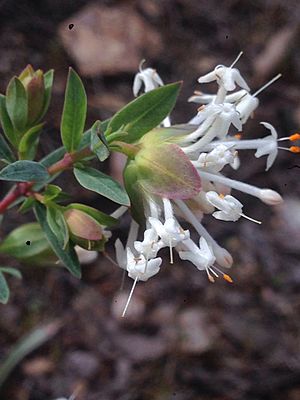Slender rice flower facts for kids
Quick facts for kids Slender rice flower |
|
|---|---|
 |
|
| Pimelea linifolia growing near Burra | |
| Scientific classification | |
| Genus: |
Pimelea
|
| Species: |
linifolia
|
The slender rice flower (Pimelea linifolia) is a common shrub found across eastern Australia. It has thin leaves that grow in pairs. Its flowers are usually white and grow in clusters at the end of its stems. Each flower cluster has four leaf-like parts called bracts at its base. This plant might be harmful to animals like sheep.
Contents
What the Slender Rice Flower Looks Like
The slender rice flower is a shrub that can look different depending on where it grows. Some plants lie flat on the ground, while others can grow up to 1.5 meters (about 5 feet) tall. Its stems are smooth.
Its leaves are also smooth and can be narrow or oval-shaped. They are usually between 3 and 40 millimeters (about 0.1 to 1.6 inches) long and 1 to 9 millimeters (about 0.04 to 0.35 inches) wide.
The flowers are mostly white, but sometimes they can be pink. They are usually 10 to 20 millimeters (about 0.4 to 0.8 inches) long. These flowers grow in groups of 7 to 60 at the end of the stems. At the bottom of each flower cluster, there are four (sometimes eight) special leaves called bracts. These bracts are shaped like a spear or an egg. They are 7 to 17 millimeters (about 0.3 to 0.7 inches) long and 3 to 11 millimeters (about 0.1 to 0.4 inches) wide.
Some of the flowers have both male and female parts (these are called bisexual), while others only have female parts. The female-only flowers are shorter. After the flowers, the plant produces small green fruits that are 3 to 5 millimeters (about 0.1 to 0.2 inches) long.
Plant History and Name
The slender rice flower was first officially described in 1793 by a scientist named James Edward Smith. He studied a plant that bloomed in a greenhouse in England.
Where the Slender Rice Flower Grows
This plant is very common and can be found all over eastern Australia. It usually grows in wet forests. Sometimes, you can also find it at the edge of rainforests.
You can see the slender rice flower in north-east Queensland, across the eastern part of New South Wales, almost all of Victoria (except the far north-west), the south-east of South Australia, and all over Tasmania.
How People Use the Slender Rice Flower
The bark of the slender rice flower can be used to make a strong, thin thread. This thread was traditionally used to catch the bogong moth (Agrotis infusa).
People would make this string, sometimes called a 'Bushman's bootlace', by wetting, drying, beating, and rolling the plant material.

